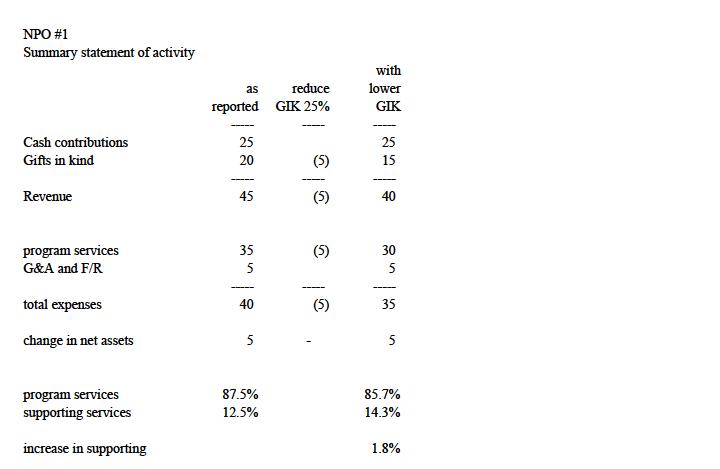Before looking at some actual financial statements that have been affected by the changes in valuation of GIK, I thought it would help to look at a simple picture.
This is a continuing series of posts looking at deworming meds, especially Mebendazole, which started here.
A major component of this discussion is new accounting rules that change the definition of how to value GIKs. Those changes are discussed here.
I am quickly learning that this whole GIK valuation thing is a bigger issue than I realized and already has some interest. I hope I will be able to contribute to the discussion from the accounting side.
To illustrate the change in valuation rules, I have made up two sample financial statements. The numbers are small and simple so we can see the overall picture. I set the internal relationships so they are representative of an actual NPO.
In my next few posts I plan to look at the financial statements of a few organizations that changed their valuation of GIK as a result of the new accounting rules. Examples I give here provide a roadmap on how I will talk about the actual financial statements.
Example 1
Let me tell you the story of NPO 1’s financial statements in words and then I will describe it in numbers.
NPO 1 has cash income of $25. They spent $15 of cash on program services and $5 cash on general & administrative and fundraising costs. I will combine the G&A and fundraising into supporting services for this discussion to keep the illustration simple.
They have $5 on the bottom line (called change in net assets). This organization also has $20 of GIK which flows into income and program expense.
In my career I have found the best way to analyze program services and supporting services is to compare those amounts to total expenses as a percentage. This removes from the discussion swings in the change of net assets and growth over time. That lets me focus on the portion of expenses that are going to program compared to supporting services.
So, for NPO 1 the program services are 87.5% of total expenses and supporting services are 12.5%.
Here is the story in numbers:
(click to enlarge)
Now, let’s change that to reflect a reduction in the valuation of GIK due to new rules regarding fair value. I’m going to pull an assumption out of thin air that the new rules reduce the dollar amount of gifts in kind by 25%.
In other words, GIK in the current year would have been worth $20 if we used the previous definition of fair value but is now worth $15 using the new definition of fair value.
So GIK revenue drops by $5. Since the GIK expense goes completely to program services that means that program service expense also drops by $5. That changes the proportion of program and supporting services.
In the above example you can see $5 taken out of GIK income and program services. You can then see that program services are now 85.7% of total expenses and supporting services are 14.3%.
This example has isolated the change in GIK valuation as the only change between those two calculations. The impact of reducing the GIK valuation by 25% is to increase supporting services from 12.5% to 14.3%. That is an increase of 1.8%.
Therefore the organization appears to be less efficient, even though it is working at the exact same efficiency as it was before. Nothing changed in their operations other than the value applied to GIK.
Example 2
I will use far fewer words to describe the second organization.
This organization’s cash income is $30 and they spend $20 cash on program services. More importantly they receive $140 of GIK. They get 82% of their income from GIK compared to 44% in NPO 1.
Their program services are 97.0% of total expenses with supporting services at 3.0%.
Here is their story in numbers:
(click to enlarge)
Let’s now assume that using the new definition of fair value reduces NPO 2’s GIK by 25%. Again, I pulled that 25% out of thin air. Their revenue drops by $35 and program services drop by the same amount.
Their program services are now 96.2% with supporting services at 3.8%.
The change in GIK valuation rules increased their supporting services from 3.0% to 3.8%, which is an increase of 0.8%.
As before, the only thing that changed is a new valuation applied to the same volume of GIK materials. Yet the calculated ‘efficiency’ went down.
Therefore NPO 2 also appears to be less efficient. The impact is not as great as for NPO 1, because GIK as a portion of total revenue is far higher for NPO 2 than NPO 1.
Conclusion
The above examples illustrate the impact of dropping GIK valuations by 25%. You can use the same format to analyze the financials any other way you want.
Mr. Barrett and others have focused on how changes in the GIK valuations have had a significant impact on the total revenue of organizations. Articles you will read mention the impact on efficiency, but don’t go into a lot of accounting detail.
You can now see how changing the valuation of GIK meds can have an even more dramatic impact on the apparent efficiencies. Increases in the examples are adding 1.8% on to 12.5% or adding 0.8% on to 3.0%. That is a big change.
Next posts will look at the impact of the new accounting rule on several organizations.


One thought on “What impact does a change in GIK valuation have on financial statements? (Part 4 of a series)”